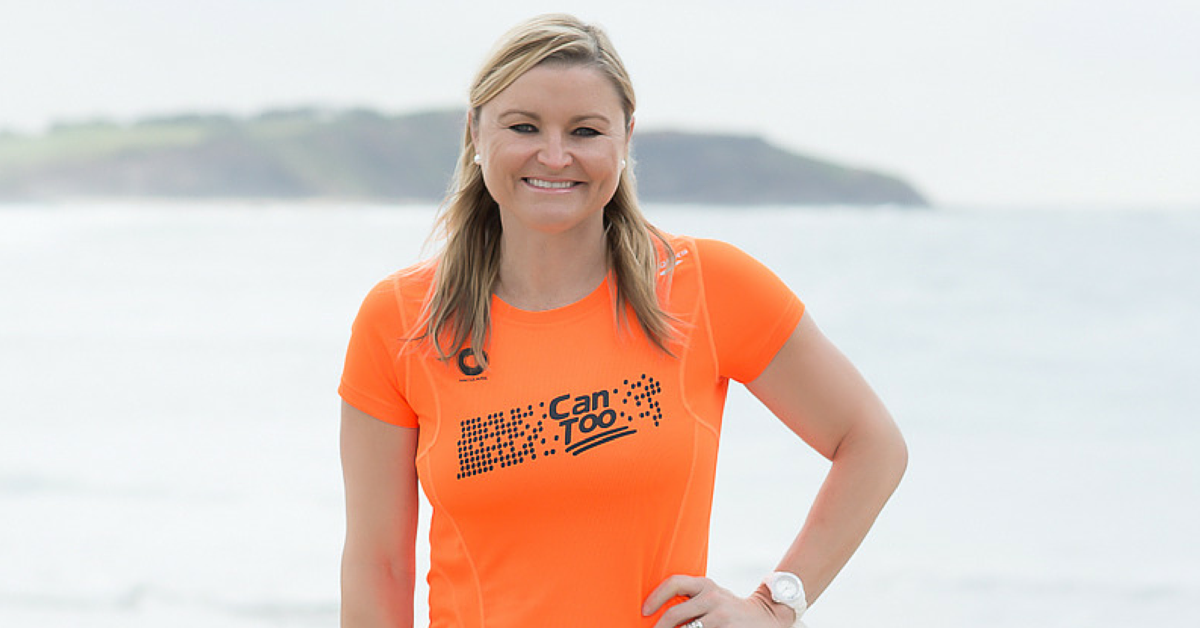
As the mood dips and temptation to take your foot off the exercise pedal increases, Can Too Ambassador and former Australian Olympic sprinter Melinda Gainsford-Taylor says it’s the ideal opportunity to combine your fitness goal with finding a cure for cancer.
Melinda is arguably Australia’s greatest female sprinter of all time, and one of more than 17,000 people Can Too has trained since 2005.
Having lost her Mum to cancer in 2015, Melinda successfully completed her first marathon after training with Can Too in September of the same year.
“As someone who was used to training for events that were over in seconds, the thought of running a 42km marathon was way out of my comfort zone,” she said.
“Thankfully, Can Too’s running programs are designed to help people of all fitness levels and abilities achieve their fitness goals, and after 20 weeks of Can Too training, I was able to realise my goal of running the 2015 Blackmores Sydney Marathon in memory of my dear mum, while raising much needed funds for cancer research. It’s by far one of the most rewarding things that I have ever done,” she said. Find out more about her journey with Can Too with her letter to her younger self.
To help you get running, especially if you're locked down, Melinda offers the top tips that helped her prepare for her transition into distance running:
#1. Prepare for Excuses
Hitting the snooze button in favour of stepping out onto a cold bedroom floor and scourging for clothes in the dark will always seem like the better option than a morning run at 5am, cautions Melinda. To keep those early morning excuses at bay, Melinda advises you prepare for your morning run the night before. “Make sure you lay your running clothes out so they’re easily accessible and ready to step into as soon as you get up,” she says. “You can also lay your keys, drink bottle, iPod, whatever you take on your run, by the door for a quick getaway,” she adds.
#2. Get Puffed for a Purpose
Even if you're not in a Can Too program it helps to raise money for charity knowing that it’s likely that your motivation will fail you at some stage. “Knowing that you’re training for a bigger cause can give you the extra incentive when you really need it,” says Melinda. “Having lost my mum to cancer, I know all too well the devastating impact that it can have on an individual and their loved ones, and I find it so motivating to be running for a cause that will help stop cancer from taking more lives in the future,” she says. “When I don’t feel like running, or can’t be bothered to exercise, I remind myself of the greater good it’s doing and it makes all the difference,” she adds.
#3. Use the 10% Rule
“When you’re starting out make sure you don’t increase your running distance by any more than approx 10 per cent per week,” advises Melinda. For example, if you run 5km one week, wait until the following week to increase it to 5.5km. “New runners or those getting back in the swing of running are prone to injury, and going out too hard can cause a lot of damage,” warns Melinda.
#4. Keep Chatting
Believe it or not, according to Melinda, you should be able to hold a conversation and talk in complete sentences while you run. If you're running with a friend you can also enjoy this social aspect. "I’m used to sprinting and there’s no way you can have a good natter while doing that!” she says.
#5. (Don't) Just Run
If you want to become a good runner, running is the only way you’ll get there, however runners who ONLY run are generally prone to injury so you should really mix it up if you can, advises Melinda. “Depending on how much time you can dedicate to training, you should definitely throw a couple of weight or cross training sessions in the mix,” she recommends. “Three running sessions a week is fine, however if you’re training four or more days a week, incorporating low impact disciplines like ocean swimming, cycling and weights can help to increase your strength and fitness without all the impact,” she adds.
#6. Dress for Success
To avoid overheating, Melinda recommends dressing for runs as if it is 10 degrees warmer than the weather indicates. “In cooler months it is easy to over dress and you’ll always be quite cool to start off, but you’ll always warm up,” says Melinda. “Dress for how you will feel mid-run and make sure you always wear breathable fabrics that don’t cause irritation or extra sweat,” she adds.









